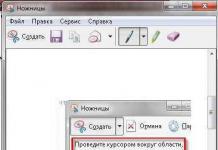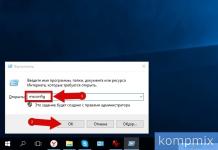Users who installed a new version of the Windows operating system on their computers went to the task manager and noticed that the “System and Compressed Memory” process of Windows 10 appeared in it. It uses a large amount of RAM. This article will describe what this process is and why it is needed.
Why is it needed?
In early versions of Microsoft's OS, this process was also present, but was called “System”. It uses a large amount of RAM and sometimes loads the processor and disk. But this is not a bug, but an improvement in the memory management mechanism in the form of the “compression store” function, operating within the framework of the “System and Compressed Memory” process. When used, the performance of applications and programs running on the PC increases (find out how to improve PC performance in the article “Tuning maximum Windows 10 performance to speed up your computer”), and the responsiveness of Windows 10 increases.
Why does it load RAM?
This function is designed to store compressed pages and data in RAM. If there is not enough RAM, information about programs is not immediately written to the hard drive in the paging file, but ends up in compressed form in RAM. This increases the responsiveness of the OS, so the “System and Compressed Memory” process uses a large amount of RAM (sometimes 4 GB).
The fact is that the data exchange speed of RAM and hard drive is different (in the first case it is much higher). Therefore, writing information about applications to disk will cause Windows 10 to slow down. Before using the page file, the new OS compresses all data and places it in RAM. This allows you to store much more information about running applications in RAM. In this case, the operating speed is reduced compared to conventional data storage in RAM, but it is still higher than when writing data to the HDD.
How to disable?
Important! If your computer is running normally and has enough RAM installed, do not disable the Compress Storage feature.

Conclusion
The Compression Storage feature, which is part of the System and Compressed Memory process, improves the performance and responsiveness of Windows 10. But it uses a lot of RAM. If you decide to disable it, you can do this in the Services window.
Read, What does memory compression mean in Windows and how to view information about compressed memory on your PC. And also, what to do if your computer does not have enough RAM and how to determine how much memory a certain process takes. Windows 10 uses compression to store more data in your system's RAM. In the Windows 10 task manager, in the “Performance” tab, information about the size and current memory usage is displayed. Among other parameters, it is indicated that part of the memory is compressed. Let's figure out what this means?
Memory compression is a new feature in Windows 10 that is not available in earlier Windows 8 and 7. At the same time, Linux and MacOS use this feature.
Typically, if your computer has 8 GB of RAM, and running applications and the system itself use 9 GB of data for memory storage, at least 1 GB would have to be stored in the page file on your computer's hard drive. Accessing data in the page file slows down the speed of individual applications and the system as a whole.
However, by using a compression algorithm (the same as in a Zip file), the data size can be reduced and fit entirely into RAM. For example, the system can leave 6 GB of uncompressed data, and compress 3 GB so that it actually takes up 1.5 GB. Thus, you will have 7.5 of the 8 GB of RAM occupied.
Are there any downsides to this approach? Yes and no. Data compression and the reverse procedure require certain processor resources. Therefore, not all data is stored compressed; the system compresses only the information it considers necessary. The compression and decompression operation itself is much faster than writing and reading data from the disk. Therefore, Windows is looking for a compromise between these two approaches.
Why doesn't Windows compress all data?
As we have already discussed, the speed of data compression and decompression is much higher than writing and reading data from disk. Working with such data occurs in a fully automatic mode and does not require user intervention, so why doesn’t the system compress all the data?
Working with uncompressed data is much faster. If the operating system needs to search through a large amount of data stored in RAM, then the procedure for reading, decoding and reverse encoding the data requires significant processor time. In addition, the system reserves part of the RAM to decompress the necessary memory buffer in case of such need.
Based on this, Windows tries to store data that is frequently accessed in a decompressed form; data that is accessed by the system less frequently is compressed or even saved to the page file.
What to do if your computer does not have enough RAM?
So what should you do if you see that the system is using a large amount of compressed data or is working with a large page file? The answer is obvious, add more RAM to your PC, this will be the best solution. It is also obvious that it is better to use as fast RAM as your motherboard allows.
A less obvious solution would be to use an SSD drive for the swap file or the system as a whole. Previously, we looked at how to move the swap file to another drive in our video:
Since the reading and writing speed on an SSD disk is many times higher than that of a traditional hard disk, the entire system will work faster.
How to View Compressed Memory Information on Your PC
To view information about how much memory is compressed on the system, you need to use the Task Manager. To launch it, right-click on the taskbar and select, or press Ctrl + Shift + Esc (for Windows 10, 8) or Ctrl + Alt + Delete (for any Windows) and select.

By default it runs in a shortened form, you need to access the full version. To do this, click the button More details in the lower left corner of the window.

Go to the Performance tab and select Memory from the list on the right. You will see how much memory is compressed in the partition "Use (compressed)". For example, in the screenshot below, the task manager shows that our system is currently using 4.2 GB, 21.6 MB is compressed memory.
This setting changes constantly depending on the number of running applications and the memory they use. The amount of compressed memory may change due to system tasks running in the background; you can monitor this process in real time.

You can also see from the screenshot that our system uses 8GB of DDR3 RAM. 1 GB is reserved in hardware - this memory is used by the integrated graphics system. Memory form factor DIMM, 2 sticks are used and 2 more slots are free in the system. The 1.9 GB cached option displays the current page file size. If you hover your mouse over the diagram in the Memory Structure section, the system will display a tooltip with additional information.
How to determine how much memory a certain process takes up
To obtain detailed information on the memory that each process occupies, go to the Processes tab, then find the one you need and highlight it; the memory column will indicate the actual memory occupied.

Some applications have multiple processes running simultaneously, such as Google Chrome. In this case, it is necessary to calculate the sum of the memory consumed by all running processes.
In Windows 10 Update 1809, Microsoft has chosen a new name for the service SuperFetch, called SysMain. When we talk about the "memory" of a computer, we are typically referring to the physical RAM memory that we have attached. Microsoft operating systems have additional features and capabilities such as virtual page file memory or compressed memory (SysMain). Designed to maximize memory and keep your computer running smoothly even under heavy workloads.
In Windows, in addition to using RAM, it has a well-known feature called the page file (virtual memory). Space reserved on a hard drive to allow memory to be loaded and information to be stored. Thus, when there is not enough RAM, programs in need of memory turn to the paging file on the hard drive. With the advent of Windows 10, Microsoft introduced a new feature to the operating system (which had already existed for some time in Linux and MacOS) called " SysMain". It is the best alternative to regular virtual memory in earlier versions of Windows 8, 7, XP.
What is SysMain in Windows 10?
SysMain is a feature that was introduced back in Windows Vista, under a different name as SuperFetch. It sits quietly in the background, constantly analyzing RAM usage patterns and learning which apps you run most often. Over time, SysMain marks these applications as "frequently used" and pre-loads them into RAM. The idea is that when you want to launch the application, it will launch much faster because it is already loaded into memory.
As I said above, " Host Service: SysMain" is a new feature released with the release of Windows 10 that aims to be an alternative to the page file, improving overall computer performance. Unlike the page file (which can be enabled, resized, disabled, etc.) this option is enabled by default in Windows 10 and works without our intervention.
In earlier versions of Windows 10, SysMain was called as SuperFetch and was associated with the process " System", which was surprising that this process was consuming large amounts of memory. With the Creators Update, this setting is recorded in the Task Manager section as Memory structure.
SysMain is the best paging file option, but it is not without a flaw since the system will constantly use the processor cycle to access compressed memory, which can slow down the computer.
How does SysMain work on Windows 10?
Default SysMain designed to occupy all available RAM space with pre-loaded applications. Don't worry, this is only about unused memory. As soon as your system requires more RAM (for example, to load an application that was not preloaded), it frees up the required memory as needed.
Before Windows 8.1, if an application needed to use, for example, 5 GB of memory, and the computer only had 4 GB of RAM, then Windows was forced to send 1 GB of this data to the page file on the hard drive. Thanks to this virtual memory, it becomes possible to run and use this program, but it will work slower than with enough RAM.
Starting with Windows 10, when the operating system needs more memory than it has available, then the process occurs compress data like ZIP into RAM, instead of sending them to the hard drive in the page file. Thus, if we need to store two data packets of 6 GB and 3 GB and the computer has only 8 GB of RAM, then Windows 10 compresses the 3 GB packet by reducing it to 1.5 and receives a total of 7.5 GB instead of 9 GB and can receive it accesses from RAM without resorting to exchange.

Is it good or bad to have SysMain?
Windows will try to avoid using this method when there is available RAM, but when some data requires a large amount of memory and there is not enough RAM, the system will compress the data into RAM to save resources and try to force the computer works well.
Most of the data is stored in RAM so that the system can access it directly and without problems. In virtual memory, or as it is also called, data is stored on the hard drive, thereby reducing the time it takes to access data from the hard drive to RAM. Some users see that the memory is sometimes filled with 3.5 GB, but this is not so bad when your hard drive can be 100 percent from the page file. You just need to wait until the data in RAM is compressed.
- If anyone wants to Enable or Disable" Host Service: SysMain", then find the service SysMain in Device Manager. There is only one conclusion and it is obvious that compressed memory is much better than the page file, which is even on an SSD drive.

Tens users have noticed that a process called “System and Compressed Memory” in Windows 10 consumes a significant amount of system resources (loads the processor and consumes RAM).
The factors behind this behavior of this process can be very diverse, but most often a significant load on the system is a problem associated with some computer component or its driver. Let's look at the possible causes of the problem and get rid of them.
“System and Compressed Memory” is a new component of “tens” that performs one of the control functions of this operating system. It allows you to reduce the number of calls to the paging file (pagefile.sys) on your hard drive by storing part of the data located in it in a compressed form in RAM.
In theory, everything should work great, but in practice everything results in a significant load on the computer with unnecessary tasks. And not all users are ready to put up with such Microsoft policies.
For owners of computers with plenty of RAM: unless you use applications that consume a lot of RAM, which is extremely rare with powerful PCs, you should not worry about this process consuming a fair amount of RAM.
After all, consuming several gigabytes of RAM out of 16 GB present is quite a bit, but if you have 4-8 gigabytes of RAM, which are spent on the functioning of Windows 10 and user applications, “eating” a couple of gigabytes can affect the performance of the computer.

Factors Causing Increased Resource Usage by the Compressed Memory and System Process
Let's look at the common reasons why "System and Compressed Memory" Windows 10 consumes a lot of computer hardware resources.
System software (drivers)
Monitor when the problematic process begins to consume the most resources. If this happens after resuming from sleep/hibernation mode, or the problem began after reinstalling Windows or updating drivers, the source of the problem is most likely a driver for the motherboard or chipset.
Here, everyone must individually decide what actions to take: roll back the drivers, update them to the latest version, replace them with an older but stable edition, completely remove them so that Windows 10 will automatically install them, perform a system rollback, etc.
The best option to try first is to update the system adapter driver from the device support site.
You should also keep the following points in mind:
- Most often, the culprits are drivers for managing the power system from Intel, ACPI, SCSI and AHCI drivers; it is especially worth noting applications for firmware and working with BIOS and other low-level software.

- As a rule, the “top ten” handles the installation of the drivers listed above automatically and offers to update them through the Update Center, so you will never see information in the task manager that a more recent version of the driver has appeared. But the disadvantages of implementing such a function are that the OS does not always correctly select the most suitable driver and Windows 10, soon after manually installing the desired product, can replace it with its own (sometimes less suitable one). This is what leads to problems. To get rid of them, you should acquire the latest release of system software from the developer’s resource (under no circumstances use driver packs and applications to update drivers), install it and prohibit the “top ten” from finding and installing updates for these drivers using the official utility.
- Pay attention to the video adapter driver. It should also be reinstalled from the archive obtained from the link on the support site for your video card. Before installing new software, you need to get rid of all files of the old version of the software using the Display Driver Uninstaller application.
If manipulating the drivers did not bring success, we move on.
pagefile.sys settings
The above method is much simpler than the previous ones, but is relevant for fewer cases, which is why it comes in second place. Although beginners are recommended to start looking for the source of the problem from there.
- Disable the page file and restart Windows 10.
- After working a little, we check how “Compressed memory and system” behaves.
- When everything is fine, try re-enabling pagefile.sys on the system and restarting.
- If the situation is not resolved, set a smaller page file size and check for the problem after restarting the PC.

Security Software
When using an old favorite antivirus that does not support Windows 10, the problem described above may most likely appear due to incorrect operation of memory during RAM scanning. Update your antivirus.
Conflicts when operating a pair of antivirus programs are also not excluded, especially when 2 more antiviruses are installed on the PC, in addition to the one integrated into the Top Ten. Keep only one application to protect your PC. Sometimes firewalls are also involved in the fact that the System and Compressed Memory process consumes a lot of RAM. Disable the traffic filtering utility and check the behavior of the process.
Chrome
It has been noticed that when running in the background, Chrome causes the new Windows 10 process to use a lot of RAM. The following manipulations will help get rid of this.
Deactivate the hardware acceleration feature in Chrome.
1. Call up the browser settings menu and click on the button located below, which is responsible for displaying additional settings.
2. Uncheck the box next to the “Use hardware acceleration” option.
3. Restart the web browser.
4. Find “Hardware acceleration for video decoding” and disable it.

5. Find the option “Do not disable services running in the background when the browser is closed” and uncheck the box next to it.
6. Restart the browser and observe the “System/compressed memory” process.
Less common ways to get out of a situation
If you are one of those users who were not helped by all the above recommendations, tips and instructions, check out the latest options to solve the problem. They are the least common, but who knows, maybe your case is one of the exceptions.
1. When using Killer Network drivers, you should completely remove them, for example, using Revo Uninstaller, clean the registry of any remnants, and reinstall the latest version.
2. Disable the “RunFullMemoryDiagnostic” task in the scheduler. Open the scheduler library by calling it through the search bar. Go to the address - “Microsoft” - “Windows”, in the “Memory Diagnostic” section we find the task and deactivate it, after restarting Windows.

3. Open the registry editor and go to the path HKLM\SYSTEM\ControlSet001\Services\Ndu. Change the value of the Start key to “2” and reboot.

4. Scan system files for damage.
Run the command “sfc /scannow” in the Win→R command interpreter window or the command line.
5. Deactivate the SuperFetch service and exclude it from autostart.
Execute services.msc through the command interpreter (opens Win→R). We find the named service, call its “Properties”, set the startup type as “Disabled” and complete its operation.
6. As a last resort, we try to manipulate with disabling hibernation, fast startup and sleep mode.
7. Don't forget about malware.
If all else fails, you will have to look for the cause of the problem yourself or resort to more radical solutions: rolling back Windows, resetting it, or reinstalling it.
Windows 10 uses memory compression to keep more data in system memory than was possible the old way. If you go to Task Manager and look at the CPU usage details, you will see that some of the memory on your system is “Compressed”. Let's figure out with you what this means.
What is memory compression?
Memory compression is a new feature in Windows 10 that is not available to users of Windows 7 and Windows 8. However, on Linux and MacOS operating systems, memory compression technology is quite accessible and successfully used.
Typically, if you have 8 gigabytes of RAM available on your system, and applications have as much as 9 gigabytes of content to store in RAM, then at least 1 gigabyte is "swapped" and stored in the page file on your computer's disk. Accessing the page file is much slower compared to RAM.
Thanks to memory compression, some of the 9 gigabytes of content can be compressed (just like a ZIP file or other compressed content) and stored in RAM. For example, you might have 6 gigabytes of uncompressed content and 3 gigabytes of compressed content, which would take up 1.5 gigabytes of RAM. You will be able to store all 9 gigabytes of original content in your 8 gigabytes of RAM, since it will only take up 7.5 gigabytes with compression applied to some of it.
Is there any downside here? Well, yes and no. Data compression and decompression requires some CPU resources. It is for this reason that not all data is compressed, i.e. they are compressed only if your Windows 10 operating system deems this a necessary and useful step. Compression and decompression of data using processor resources is much, much faster than uploading data and reading it from a file on disk.
Is it bad to compress memory?
As we have already indicated above, compression and decompression are a much more profitable alternative compared to classic uploading data to disk. Believe me, it is much faster than using a swap file. There are no downsides to memory compression. Windows 10 will automatically compress data in memory if it needs additional space, and you don't even have to think about this feature.
However, memory compression still consumes some CPU resources. Your system may not perform as well if it experiences memory compression. If you see a huge amount of compressed memory and suspect that this is the reason why your computer is running slowly, then the only solution to this problem is to install another stick of RAM in the system. If your computer does not have enough physical memory for running applications, memory compression is obviously better than a page file, but stick RAM is the best solution.
How to view details about compressed memory?
To view information about the compressed memory on your system, you will need to use the Task Manager. To open it, right-click on the Start Panel and select "Task Manager". You can also press the key combination Ctrl+Shift+Esc or press Ctrl+Alt+Delete, and then click the “Task Manager” item.

If you see a simplified version of the Task Manager interface in front of you, then click on the “More details” option in the lower left corner of the window. Next, go to the “Performance” tab and select “Memory”. You can see how much memory is under compression in the “Used (compressed)” item. For example, in the screenshot below you can see that the system is currently using 4 gigabytes of RAM, 263 megabytes of which are under compression.

You can see how this number changes as you open and close different programs. It can also change while the operating system is running in passive mode. If you move your cursor over the left side of the strip that displays the one reserved for compression, you will see more information about it.

Does compression cause more memory to be consumed?
In the original release of Windows 10, there were indeed problems with resources consuming more memory while applying compression. This was even stated on the official Microsoft blog.
However, at some point, Microsoft changed the way memory compression works. Memory compression is no longer shown as part of the system process in the Task Manager (possibly because this image was very confusing for many users). Instead, it is now visible in the Memory details in the Performance tab.

In the Windows 10 Creators Update, it became clear that it is only possible to see memory compression data in the “Memory” details, and the system process remains at 0.1 megabytes of use when the system has a lot of compressed memory. This saves you from confusion, since users no longer complain that the system process consumes a mystically huge amount of memory.
Found a typo? Select the text and press Ctrl + Enter


























